Plyometric Exercise
Plyometric exercises are aerobic workouts that improve your speed, endurance, and power. They need you to exert your muscles to their maximum possibility in short periods. This exercise also known as jump training, and plyometric training is usually geared toward highly trained athletes or people in peak physical condition. However, they can also be done by people who like to improve their fitness.
What are plyometric exercises?
Plyometric workouts can induce stress to the tendons, ligaments, and lower-limb joints, especially the knees and ankles. You must have the strength and fitness level necessary to do these exercises safely and effectively. If you are adding plyometric movements to your workout routine, work up to them slowly. Slowly enhance the duration, difficulty, and intensity of the workouts.
If you are looking to crank up the intensity of your exercise, may we advise adding plyometric exercises to your daily routine? These difficult moves can supercharge any session plus supply some serious benefits in the process.
Plyometrics workouts are intense workouts that require you to develop a large amount of force in a short period. The movements involve your anaerobic system, which fuels your body during training that’s so intense you can not keep it up for more than a couple minutes at a time, as you earlier reported.
Likely, you are already familiar with plyometrics, even if you haven’t heard the term before. For example, a box jump, burpee, hands-release or plyometric push-up, and pop squat are examples of plyometric exercises.
Plyometric workouts may have been a part of your workout routine or your preparation for a sport requiring a lot of explosive movement, like basketball, soccer, or track. Or maybe you’ve watched others perform intense plyometric exercises but haven’t given these challenging exercises a go yourself. Additionally, you are not required to do this in a gym.
You can try a variety of plyo exercises with just your body weight at home. And incorporating plyometric exercise into your routine can have plenty of advantages. Do it safely.
What kind of exercise are plyometric moves?
Plyometrics workouts are extremely strength exercises since they are all around accomplishing explosive exercises at the highest effort (or close to max effort). Plyometrics workouts are also good for enhancing your power since your muscles have to work tough to do them perfectly. And plyometrics can count as cardio, too, since they are high-intensity workouts that will get you breathless fast. That is why you will commonly see them programmed in HIIT workouts.
Many people think that plyometrics is a type of isometric exercise technique. plyometric involves fast movements and concentric (shortening) and eccentric (lengthening) muscle contractions that’s why looks like an isometric. An isometric movement, by contrast, involves muscles staying super still while they perform. the plank exercise is an example of isometric.
In terms of which muscle groups plyometrics work, for the most part, they are whole-body movements. many plyometric exercises—like jumping lunges, pop squats, and tuck jumps—put an extra emphasis on your core and lower half. Plyo push-ups and explosive medicine ball throws are two examples of plyometric exercises that target the upper body.
What are the benefits of plyometric exercises?
Plyometric workouts help train a person’s muscles to react with power and efficiency. The potential advantages of this training process include:
- Improved power output in the muscles
- Improved force in muscle squeezes with less energy consumption
- More rapid speed of muscle contractions or speed in general
- Enhanced ability to switch directions fast, which fitness professionals may refer to as agility or agility
- Overall better control when quitting and initiating movements
- Improved jumping height
- Reduced risk of damage to the joints and muscles
An individual should perform with a trainer on an individualized training plan. Different activities can help focus on the specific areas in which they want to improve. For illustration, a baseball player may wish to concentrate on exercises that may help them throw a ball farther or sway a bat with more force. Conversely, a football player may be required to focus more on lower-body workouts that help with quick changes in direction and running speed.
There are many advantages of plyometric workouts that might just convince you to add them to your exercise routine. They can assist increase speed, strength, endurance, agility, and coordination. Plyos can also increase tendon strength and improve your rate of force development—basically, your body’s ability to develop a lot of power fast. This can come in handy for athletes whose sports need them to perform fast, powerful actions—like track athletes, for instance, or volleyball players.
Plyometric exercise can also help lower your risk of injury both in sports and at the gym since it improves your body’s ability to quickly absorb shock. The majority of injuries happen when the body moves outside of its controlled range of motion. For example, if you jump up to block the ball in a game of beach volleyball and do not land back on the floor with good mechanics, you could pull a muscle, tendon, or ligament. By increasing your capacity to really and safely absorb shock, you can lower your risk of injury in sports and fitness environments with a solid plyometric workout.
One more great advantage of plyometrics is they are a good bang-for-your-exercise-buck. They are a good choice if you are short on time but still want to get in some serious training because they are high-intensity activities that can offer many benefits faster than lower-intensity activities.
Are plyometric exercises safe?
The great advantages of plyometrics come with a big caveat: There is a higher chance of injury with these moves than with more traditional strength exercises or cardio since they are a high-impact form of training performed at max effort. For this reason, mastering a movement’s fundamental form—such as lunges—is crucial before incorporating a plyometric component—such as jump lunges. This implies that if you’re new to working out, you should probably wait to do plyometric exercises until you’ve gained some experience. Beginners should first become familiar with performing the exercises in their traditional forms.
It’s not just about perfecting a move when it comes to plyometrics. The coming down, or the final portion of the move is also crucial. When I conduct plyometric training, I always start with the mechanics of landing. Before I instruct someone in jumping, I would like to show them how to land properly. This involves landing softly and efficiently absorbing impact before landing back on the ground.
In a jump squat, for example, proper placement would involve arriving softly (as opposed to letting your feet hit the ground), keeping your knees slightly bent so they don’t collapse inward, engaging your core, and maintaining a strong upper body to prevent swaying back and forth. Before adding a plyometric component to intensify the movement, it’s crucial to ensure that, in addition to landing mechanics, you can perform the entire movement with confidence.
Another important part of safety advice is to always make sure you’re warmed up before performing any kind of plyo exercise, as going in the cold can make you more likely to get hurt. To make sure his body is prepared for these exercises, Experts usually like to add them in towards the middle or end of a workout. When you do begin plyometric exercises, pay close attention to what your body requires. Should you detect a deterioration in your form, you have two options: reduce the intensity of the exercise to restore proper form (e.g., lower the height of your box jumps) or simply stop doing plyometric exercises altogether (e.g., return to regular lunges instead of jump lunges).
How can plyometric exercises be worked into your fitness program?
Feeling excited to do a plyometric workout and get its benefits. That is awesome! But there are a few components you should know first. First off, participating is “not something you want to do regularly. The “right” amount of duration per week to include plyo work depends on your objectives and fitness level. But in broad, plyo beginners should begin with one to two days a week of plyo work and slowly ramp up the intensity from there.
To give your body enough time to heal between plyo sessions, make sure you schedule a sufficient amount of rest. If you feel too sore from yesterday’s training to do today’s plyo set with good form, listen to your body and scale back your plans. Attempting plyo activities when your body isn’t working at its peak can lead to injury.
When you feel ready to sprinkle in plyometric activities, begin with a low repetition count. experts recommend between three or five repetitions as a general starting place. You should decrease the number of reps because you will be exhausted. Additionally, make sure your body has enough time to recover between sets and repetitions so you can maintain proper form and give every plyometric exercise your best effort, if not your absolute best. Just remember to pay attention to how your body feels and adjust your rest periods accordingly. An appropriate amount of rest will depend on your fitness level, your goals, and the difficulty of the particular exercise.
The 3 components of plyometric patterns
Plyometrics affects three phases in every cycle:
- Eccentric Component: This stage of plyometrics affects the muscles holding potential energy as they get prepared to perform a motion. It is also referred to as the cocking, loading, yielding, deceleration, or absorption phase by some people. An illustration of this stage is when a person falls into a crouched position before making a jump.
- Amortization component: During this stage, the muscles experience dynamic stabilization. They transition from overwhelming gravity and loading the energy to releasing it. The longer this stage lasts, the more likely energy gets lost. The energy that is released is more potent the shorter the duration.
- Concentric component: The last phase, the concentric element, affects contracting the muscles to remove the stored energy. A step happens during a crouched jump when the person uses their leg muscles to lift themselves off the ground and into the air.
How Plyometrics Works
Hoping, skipping, and jumping around the floor is a great way to bring back memories of your childhood. The workouts you do with plyometrics mimic those dynamic activities. Plyometrics (“plyo,” for short) utilized to be called “jump training.” It’s a method you can use in many additional ways. For example, you can perform plyometrics to assist train for basketball, volleyball, tennis, or any other action that utilizes explosive exercises.
You will perform a series of jumps and hops like jump squatting or one-leg hops. One might jump onto a box or bench, or climb over cones. Some movements will be faster than others. Your muscles are pulled instantly when you land a jump. That gives your next jump even more energy. The combination of stretching and tightening your muscles beats them into shape.
You would not do plyometrics regularly, because your muscles will require a break from all that jumping. If you are not active now, you may be required to begin working on your basic fitness first and later have a pro show you how to do the moves, so you don’t get hurt. It improves your muscle power, strength, balance, and agility and is an enjoyable substitute for regular power training exercises. You can either perform a plyometric exercise or incorporate a few plyometric movements into your routine without dedicating an entire session to them.
Intensity of Plyometrics
This exercise uses maximum power to strengthen your muscles. The movements are fast and explosive, so ready to use a lot more energy than you perform in a typical strength training session.
Areas Plyometrics Targets
Core: No. This training does not specifically target your core.
Arms: No. Most plyometric exercises do not target your arms. But if you like to work them, you can add upper-limb movements, like medicine ball throws and plyometric pushups.
Legs: Yes. I hope all of your hopping and bouncing helps your legs get in fantastic form.
Glutes: Yes. Activities like jump squatting fire up your glutes to make them stronger.
Back: No. Though the training affects your entire body, it is not concentrated on your back muscles.
Plyometrics Workout Type
Flexibility: Yes. The basis of this training is a combination of stretching and contracting your muscles, which improves flexibility.
Aerobic: No. It is not considered an aerobic workout, but if you repeat your jumps without pausing, for about 30-50 seconds at a time, your heart rate will rise.
Strength: Yes. This training is all about boosting your muscle power.
Sport: No.
Low-impact: No. A lot of high-impact hopping and jumping occurs.
Plyometric Exercises
Here are some plyometric exercises you can do to make your own HIIT plyo workout at home using just your body weight.
Pop Squat
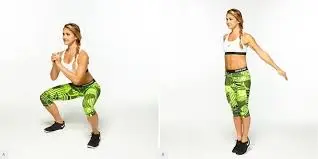
- Begin with your feet wider than hip-width and perform a squat by sending your hips back, flexing both knees, and bringing your palms together in front of your chest. To stand, keep your core tight and use pressure through your glutes.
- when you stand up, place your arms by your sides and jump to bring both feet together, taking a hop-in position.
- Instantly jump the feet apart and sink into squatting again. That is 1 repetition. Continue completing reps, hopping once in place between per squat.
- This activity is a plyometric variation of squatting, a classic lower-body workout that targets your quadriceps, glutes, and core.
Split Squat Jump
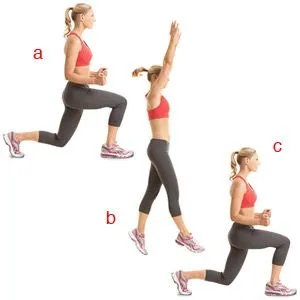
- Keeping your left foot firmly placed, step forward with your left foot like you’re performing a forward lunge, keeping your hands by your sides and your feet beneath your shoulders.
- Bend both of your knees and form a 90-degree angle with your legs. With your torso slightly forward and your chest upright, your back should be flat rather than arched or rounded forward. Your left knee should be above your right foot and your left quad should be parallel to the floor. Your butt and core ought to be cooperating. This is how a split squat is performed.
- Push through your left foot and bring your arms together in front of your chest to jump as high as you can. As soon as you land gently, go back to your split squat position. That is equivalent to one rep.
- Complete each repetition focusing only on one side. Next, switch sides and repeat on the other side.
- This is a plyometric version of the split squat, another classic lower-body exercise that works your legs and glutes.
Alternating Lunge Jump

- To lower yourself into a lunge, bend both knees. Jump with both feet forward and backward while maintaining your core engaged. To lower yourself into a lunge, bend both knees.
- Move both feet to the initial position by hopping.
- Step forward with your right foot, then back with your left, and land in a lunge on the opposite side. That amounts to one rep.
- This move is comparable to the split squat jump, but it’s a little more difficult because you have to switch up your foot placement. It also requires more coordination.
Reverse Lunge to Knee-Up Jump
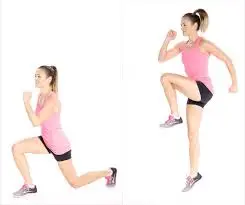
- Keeping your feet shoulder-width apart, position upright, and contract your core.
- With your right foot, take a step backward, getting on the ball of your foot and lifting your right heel off the ground.
- Both knees should be bent to a 90-degree angle as you lower yourself into a lunge. Swing your arms forward and slightly backward, respectively, bending the elbows of your right and left arms. Don’t protrude your butt; rather, keep your hips tucked in and your core active.
- Push through your left foot and raise your right knee to your chest to make the highest possible jump.
- Gently plant your left foot, then plunge right back into another lunge. That amounts to one rep.
- Finish every repetition on a single side. After that, swap sides and carry on.
- The reverse lunge is a plyometric variation of this exercise. The main muscles in your lower body, such as your quads, glutes, and calves, are worked during the reverse lunge, and the final jump adds explosiveness.
Tuck Jump
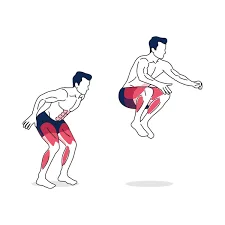
- As you stand, spread your feet shoulder-width apart. Bend your elbows so that your forearms are straight out while keeping your arms at your sides close to your body.
- As you return your weight to the back, bend your knees and push your butt back into a squat. Keep your hips from dipping below your knees.
- As high as you can, jump. Push the top of your knees towards your forearms and contract your abs as you leap. Remain erect with your back straight; avoid bending over.
- Squat again right away after landing with your feet hip-width apart and your knees soft.
- This is an advanced plyometric exercise that works your entire back and core, particularly the lower abs. When you jump or squat, watch out that your knees don’t give out.
Jump Squat With Heel Tap
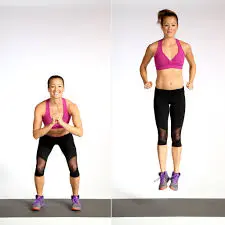
- Place your toes slightly outwards while keeping your feet shoulder-width apart. Put your hands behind your head and extend your elbows wide by opening your chest.
- To get into a squat, bend your knees, turn your hips forward, and push your butt back. Maintain a flat back, a raised chest, and a tight core.
- Jump up and push through your heels, bringing them together for a quick tap at the top. Drop straight down into the next squat after landing with your feet in the beginning position.
- This exercise tests your quads and glutes while increasing explosiveness. It is another plyometric variation of the squat.
Skater Hop
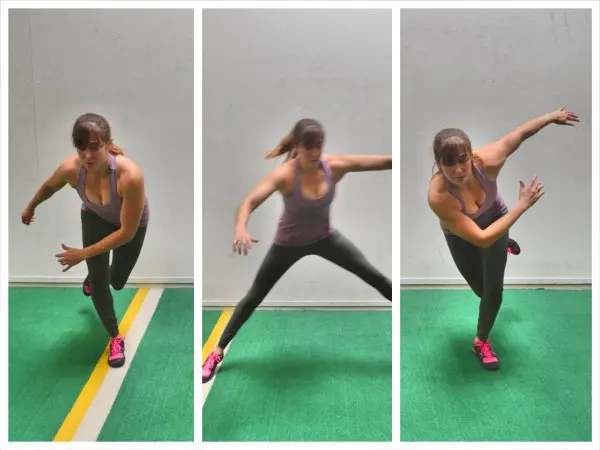
- Place your feet hip-width apart as you stand. Lean your right leg forward and make a right jump. Step forward and let your left leg straighten.
- Swing your left foot behind you while keeping it off the ground as you land on your right foot. As your right arm swings behind your back, swing your left hand in front of your body.
- Lean slightly onto your left foot and let your right foot swing behind you as you jump, swinging your left leg back to the left. As your left arm swings behind you, swing your right arm in front of your body.
- Continue, switching sides.
- This is a lateral plyometric workout that targets both your inner and outer thighs. It involves explosive side-to-side movement.
Burpee
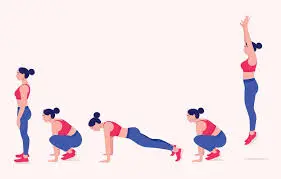
- Place your arms by your sides and your feet shoulder-width apart.
- Put your hands on the ground shoulder-width apart while squatting.
- With your hands stacked beneath your shoulders, jump with your legs straight out in front of you to form a high plank.
- Reposition your hands back on the ground after raising them briefly, then lower your body to the floor and push yourself back up to the high plank.
- Leap your feet in the direction of your hands, then launch yourself as high as you can and raise your arms above your head.
- For one repetition, gently land on your feet. Drop down into your following rep right away.
- Burpees are a plyometric exercise that works every muscle in your body, including your legs, shoulders, chest, core, and glutes.
Box Jump
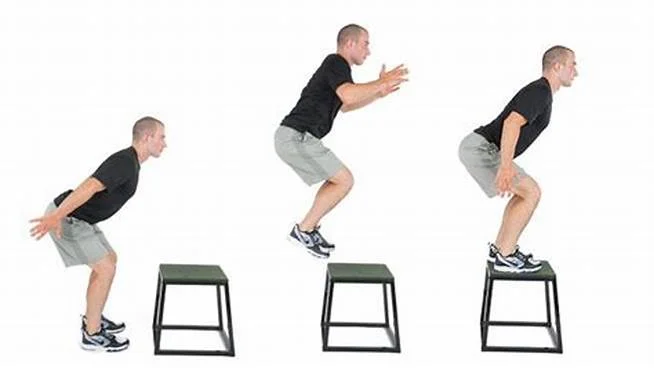
- Place your feet hip-width apart and stand on the balls of your feet approximately a foot away from a box or sturdy step.
- Extend your arms straight behind you while bending your knees to descend into a squat.
- To get up on top of the box, swing your arms forward and push through both of your feet.
- Grasp the box with both feet planted firmly, allowing your knees to bend slightly.
- To begin another rep, stand up and then take a step down.
- Before attempting this on a box, make sure you have perfected the arm swing and landing stance because it’s an advanced move. Make sure your knees do not buckle inward as you land.
Crab Walk to Jump
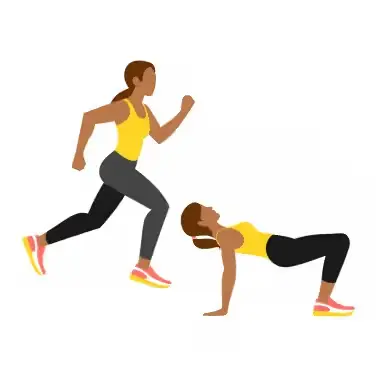
- Place your feet hip-width apart and tight your core as you stand tall.
- Drop into a quarter squat by bringing your hips back and bending your knees.
- With your left foot trailing behind, continue to squat and take a step to the right with your right foot. With your right foot, take two more steps to the right.
- Leap forward, leaping and spreading your legs wide, and throw your arms behind you to gain more speed.
- After landing softly on your balls or feet, instantly lower yourself back into a squat. do this same movement on the alternate side. One rep is this.
- Keep switching up your directions.
- The jump adds power, and the lateral walk helps strengthen your hip abductors.
Single-Leg Deadlift to Jump
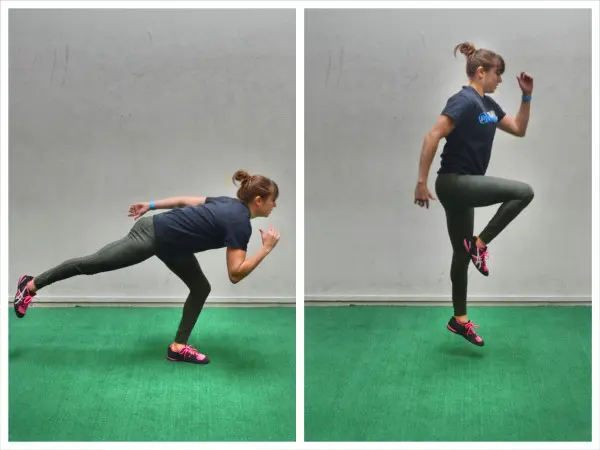
- Place your feet together as you stand. put your weight on your left leg, bend your left knee slightly, hinge at the hips, and tip your torso forward. With your knee bent and your toes pointing towards the floor, extend your right leg behind you.
- Raise your right hand towards the floor while maintaining a flat back and an engaged core. When you come to a stop, your torso ought to be nearly parallel to the ground. Push through your left heel while maintaining a tight core to get as high as you can. Bend your elbow slightly as you swing your right arm behind you and your left arm in front of you.
- After landing gently for one rep, start your next rep right away by lowering yourself into a deadlift.
- After completing each repetition on one side, switch to the other side.
- This exercise is a plyometric variation of the single-leg deadlift, a lower-body exercise that strengthens your core and works the muscles in your back, such as your hamstrings and glutes.
Lateral Lunge to Single-Leg Hop
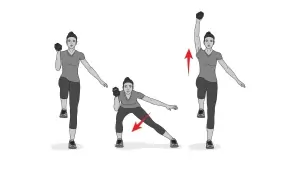
- Place your feet hip-width apart as you stand. Step quickly to the left. To lower into a lateral lunge, bend your left knee, sit back with your buttocks, and hinge forward at the hips. Maintain an elevated chest and a tense core.
- To stand again, push through your left heel, but instead of putting your foot back on the floor, bring your knee to your chest right away and jump upwards towards the ceiling.
- Step right into the next rep after landing softly on your right foot.
- You’re working in the frontal plane of motion during this lateral movement, which more closely resembles everyday motion in which we move in all directions—not just forward and backward. This exercise will also target your glutes and quadriceps.
Hands-Release Push-Up
- Beginning in a high plank position, place your hands shoulder-width apart, keep your shoulders squared over your wrists, extend your legs behind you, and engage your glutes and core.
- Lower your chest to the ground and flex your elbows.
- Straighten your arms and raise both palms several inches off the ground by pushing through your hands. Reposition your palms on the ground for one repetition.
- This exercise, a push-up variation, targets your upper body while most plyo moves target your lower body. Push-ups strengthen your core, shoulders, triceps, and chest.
Broad Jump to Burpee
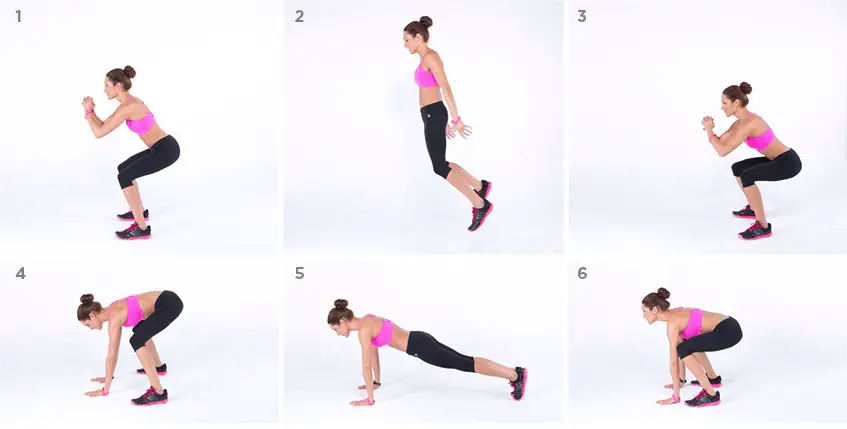
- With your arms at your sides and your feet shoulder-width apart, take a standing position.
- Take a step forward, bend your knees into a squat, and land in a squat position.
- With your hands shoulder-width apart on the ground, extend your reach ahead.
- While keeping your hands stacked beneath your shoulders, kick your legs straight out behind you to form a high plank.
- Reach down to the floor with your elbows bent.
- Your lower body should be in a squat as you propel your body back up to a high plank and leap your feet toward your hands. go back to the starting position.
- The broad jump strengthens your lower body, especially your calves, and glutes, and aids in the development of explosive power.
Burpee Into Tuck Jump
- Place your feet hip-width apart and tense your glutes and core.
- Reach forward, bend your knees, and plant your hands shoulder-width apart on the ground.
- With your hands flat on the floor just beneath your shoulders, assume a high plank position by kicking your legs straight out behind you.
- With a hop towards your hands, you can jump vertically and execute a tuck jump by bringing your knees towards your chest.
- Repeat right away after landing softly on the balls of your feet with your knees slightly bent.
- Before doing this combination, make sure you have mastered both the burpee and the tuck jump and are at ease performing them separately. This move mixes two already advanced motions.
Wall plyometric pushup

- A wall plyometric pushup, sometimes known as a “plyo pushup,” is a nearly vertical pushup that looks like a standard pushup and is executed with an explosive motion. These actions are involved:
- Place yourself facing a wall a short distance away.
- Bend forward, placing your hands against the wall while keeping your feet flat on the ground. The hands should be raised to a height between the upper waist and the chest, fingers pointing upward.
- With your arms bent, firmly push away from the wall with them. Before the body goes back to its starting position, the hands should come off the wall for a short while.
How Frequently Should You Do Plyometrics
We advise plyometric training one to two times a week in addition to a strength-based training schedule, depending on your training goals. Results would begin to appear after 4–8 weeks, similar to most training protocols.
How Long Should You Train Plyometrics
A typical session would consist of a careful warm-up, a series of targeted firing and movement pattern drills for the relevant muscles, and approximately thirty minutes. Depending on your level of fitness, plyometric drills would be brief and precise, lasting anywhere from one to twenty seconds, interspersed with one to two minutes of rest.
How to put in the most effort while reducing your chance of injury
- Pick a surface that has some give. To lessen the impact when you land, try using a thick, firm mat (not a thin yoga mat), a well-padded carpeted wood floor, or grass or dirt outside. Never jump on cement, asphalt, or tile surfaces.
- Start by targeting only a few inches above the ground. Your landing will be more impactful the higher you jump.
- As you land, bend your legs. Keep your knees apart.
- Aim for a soft landing rather than just landing on the balls of your feet or your heels.
Cautions
- If you’re a beginner or suffer from any chronic conditions or injuries, take it with caution when including plyometric exercises in your fitness regimen. Before starting plyometric exercises, it’s ideal if you already have a well-established workout regimen and are physically fit. Strong ligaments and tendons are necessary for these exercises because they may put stress on the joints.
- Plyometric exercises should be gradually added to your routine. Begin with simple, lower-intensity exercises and progress to more difficult ones. Once you’re confident that your body can handle the exercises, gradually increase the intensity and difficulty.
- Try an alternative method of exercise if you feel that plyometric training is too strenuous for you.
- If you’d like more information about this kind of training, speak with a personal trainer, exercise physiologist, or other exercise specialist. To help you get started, it might be helpful to have a few one-on-one or group sessions.
- Make sure you check in with a trainer at least once a month so they can assess your progress, offer advice, and teach you new skills. It takes proper form to guarantee safety.
- See your physician prior to beginning a new exercise regimen. This is particularly crucial if you take any medications, have any medical issues, or have been injured.
Summary
An exercise called plyometrics helps increase a person’s speed and force when performing tasks or motions by using quick, forceful movements. These workouts can help athletes perform better in their sport, but other people might gain from this guidance as well.
When beginning, one should think about collaborating with a personal trainer or other expert. A specialist can assist in customizing a program to match the individual’s objectives and needs.
FAQ
How often should I perform plyometric exercises each week?
We advise plyometric training one to two times a week in addition to a strength-based training protocol, depending on your training goals. Results would begin to appear after 4–8 weeks, similar to most training plans.
Which kind of plyometric exercise is most appropriate for a beginner?
A good plyometric exercise that targets short, rapid ground contact time is jumping rope. As you clear the rope, it also measures your coordination and height for repeat jumps. Jump rope for two minutes at first, then extend it or add more sets.
When is the ideal time to perform plyometric exercises?
The morning timing is best to perform a plyometric exercise. For plyometric training, inter-set recovery intervals of two to four minutes are advised.
Can you perform plyometric exercises every day?
You won’t perform plyometric exercises daily as your muscles will require a break from the constant jumping. If you’re not currently exercising, you might need to start with improving your basic fitness and then have a professional teach you the moves so you don’t get hurt.
Plyometrics: Is it similar to cardio?
Since plyometric exercises require your muscles to work hard to perform them correctly, they are also an excellent way to test your strength. Plyometric exercises, which are high-intensity workouts that quickly cause dyspnea, can also be considered cardio exercises. They are often programmed in HIIT workouts.
Can you gain muscle mass with plyometrics?
According to the research studies, plyometric exercise may be more effective than previously believed at increasing muscle size. The most effective exercise intervention like resistance training produced similar effects.
References
- CPT, J. M., & CPT, C. S. (2023, August 4). 12 plyometric exercises to build explosive strength and crank up your workout’s intensity. SELF. https://www.self.com/story/a-10-minute-fat-burning-plyometric-workout-you-can-do-at-home
- Cronkleton, E. (2019a, January 23). How to do 8 different plyometric exercises. Healthline. https://www.healthline.com/health/exercise-fitness/plyometric-exercises#cautions
- Solan, M. (2023, August 2). Plyometrics: Three explosive exercises even beginners can try. Harvard Health. https://www.health.harvard.edu/blog/plyometrics-three-explosive-exercises-even-beginners-can-try-202308022960
- Robinson, K. M. (2014, July 15). Plyometrics. WebMD. https://www.webmd.com/fitness-exercise/a-z/what-is-plyometrics
- Fletcher, J. (2023, June 23). How and why to train plyometrics. https://www.medicalnewstoday.com/articles/plyometrics
- Lebow, H. I. (2016, January 5). 18 Powerful plyometric bodyweight exercises for strength and speed. Greatist. https://greatist.com/fitness/explosive-bodyweight-exercises
- Developing Power: pp 121. (2019, August 26). Plyometric exercises. https://www.nsca.com/education/articles/kinetic-select/plyometric-exercises/

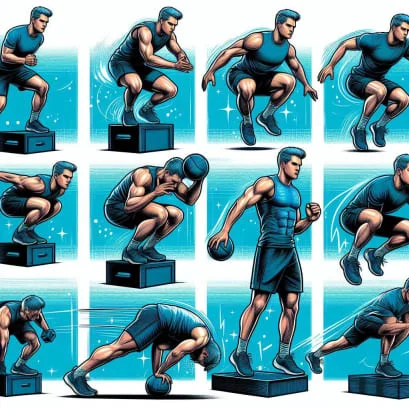
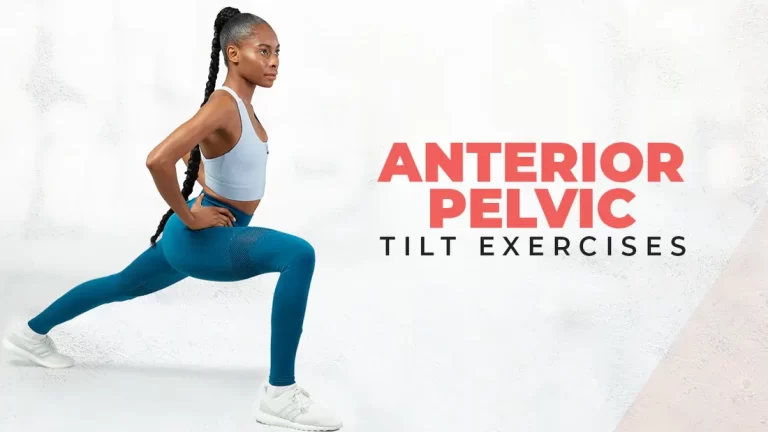
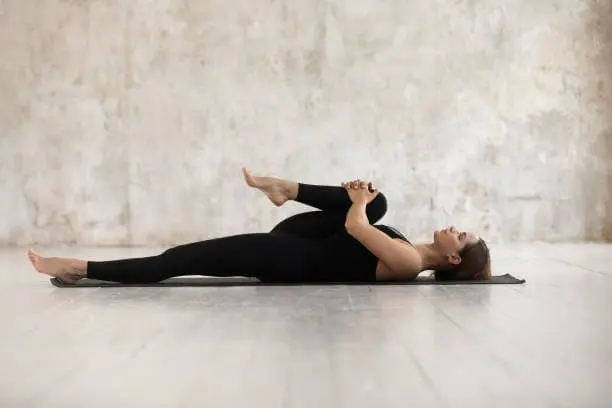
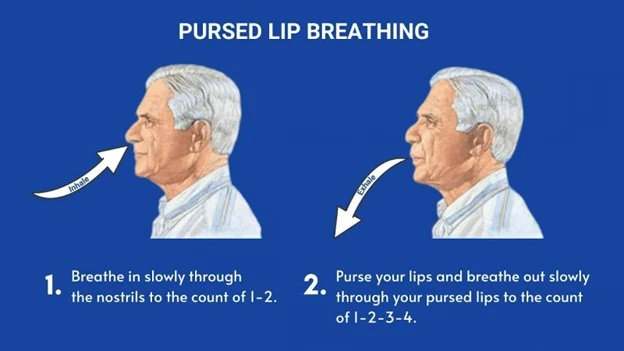

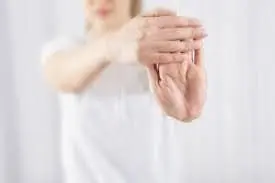
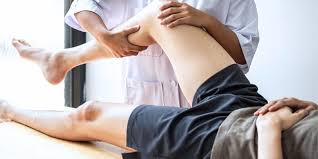
One Comment